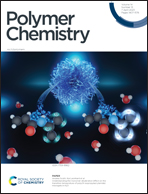Carbamate thermal decarboxylation for the design of non-isocyanate polyurethane foams†
Abstract
Polyurethane foams remain at the forefront of cushioning, insulation, packaging, and structural applications. Risk of exposure to isocyanate-containing precursors during foaming operations directly contributes to the regulation of isocyanates, thus prompting investigations into non-isocyanate alternatives. This work presents non-isocyanate polyurethanes (NIPUs) that are readily prepared from carbonyldiimidazole (CDI) derived monomers for efficient synthetic methods that strive to adhere to the principles of green chemistry. Various bis-carbonylimidazolide (BCI) monomers undergo β-hydrogen elimination at temperatures exceeding 140 °C, which liberates a carbamic acid that subsequently decarboxylates. Decarboxylation provides an in situ blowing agent, and carbon dioxide is capable of producing a microcellular foam with concurrent crosslinking. BCI difunctional monomers in presence of trifunctional crosslinking agents enabled the synthesis of both rigid and flexible NIPU foams, and the addition of conventional surfactants and catalysts allowed for precise control over pore structure. Thermomechanical analysis elucidated foam glass transition temperatures ranging from 0 to 120 °C and coefficients of thermal expansion on the order of 10−6 mm mm−1 °C. Scanning electron microscopy enabled characterization of pore size and foam structure. Optimized catalyst and surfactant levels enabled a range of flexible and rigid foam compositions. Fundamental structure–property-processing relationships were established for novel BCI-derived NIPU foams to reliably predict performance.



 Please wait while we load your content...
Please wait while we load your content...